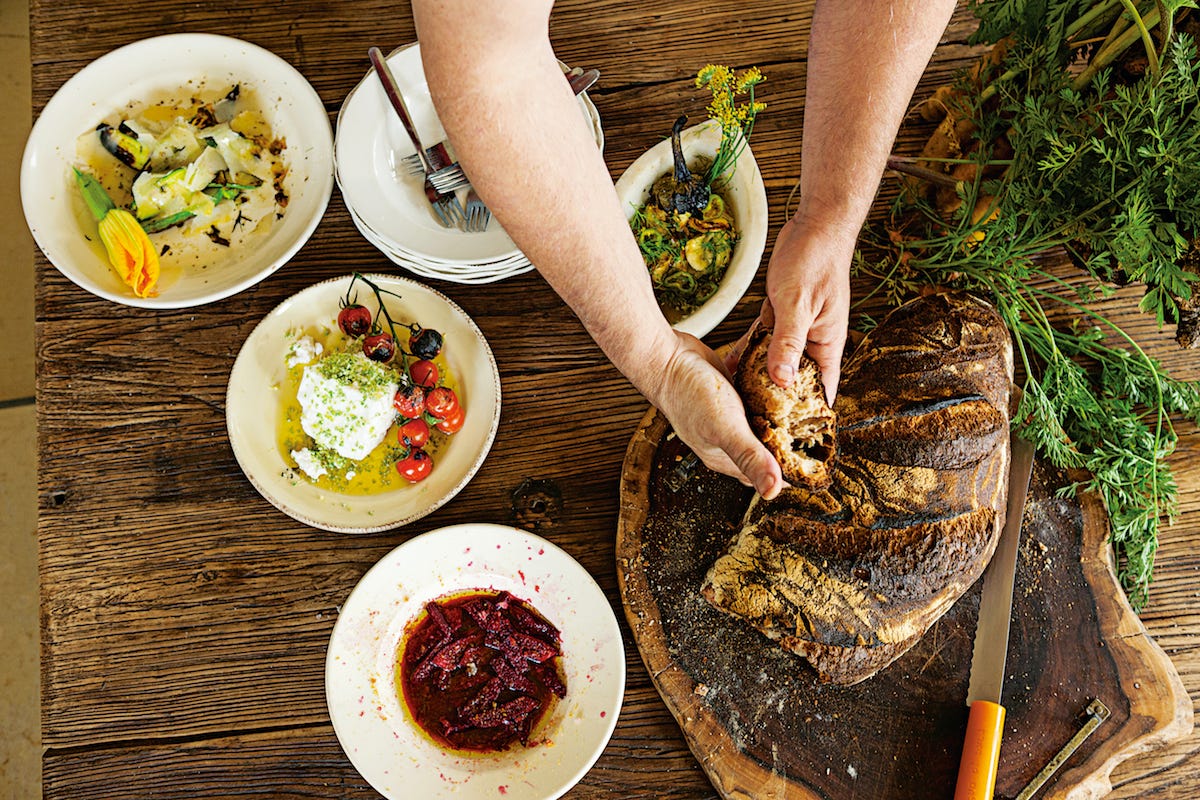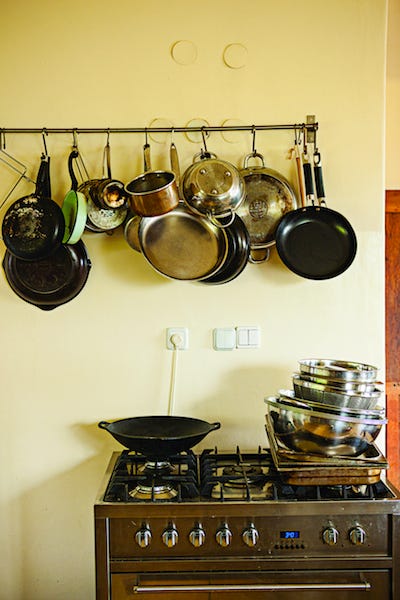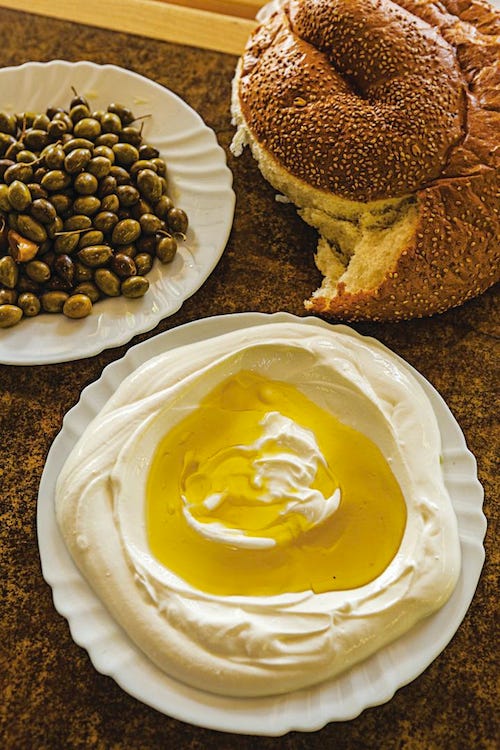
The Promised Land
In the Galilee, biblical roots, rich agricultural heritage, and Mediterranean flavors give rise to Israel’s most soulful cuisine
About an hour outside of Tel Aviv, driving north toward the Galilee, the land tells me I am getting closer to my destination. I see neat plots of banana plants and rows of avocado trees. I pass hardy date palms and fish farms with shallow rectangular pools. A stop at a gas station reveals a carob tree growing next to the parking lot and tufts of za'atar, a type of wild thyme eaten throughout the Middle East, sprouting from the curb. When I enter the Upper Galilee, subtropical hills and valleys give way to a rocky green vista of olive trees with gnarled, ropy trunks, which could be hundreds of years old. It's good to be back.
I've been to Israel before. I've seen the religious sites. As a Jewish American who spent my childhood attending Hebrew school, I anticipated having an "aha" moment in the old city of Jerusalem, or at the Wailing Wall, the holiest site for Jews. But it wasn't until I first stepped foot in the Galilee nearly ten years ago that I felt that visceral sense of the sacred so many others say they encounter here. The region, stretching from Lebanon in the north to the Jezreel Valley in the south, has been inhabited for more than 3,000 years. Somehow, the place itself telegraphs its antiquity.
The Galilee was the breadbasket of the biblical period, and more recently, the birthplace of the kibbutz, the 20th-century Jewish farming communes that harnessed the potential of this land, turning it into Israel's most fruitful region. It's also home to some of the most elemental and satisfying foods I've ever eaten: Israeli-style breakfasts of vibrant raw vegetables and soft goat's milk cheeses; specialties like hummus mashaushe, chickpea-topped hummus swimming in olive oil, and knafeh, a syrup-soaked cheese and shredded phyllo pastry, which I sampled in the Arab-Israeli port city of Akko. The cuisine here is influenced by Arabs, Druze, and Bedouins (see Original Galilee), and even by the Bible. There are flavors from the Jewish diaspora, from Europe, Africa, and the Middle East. Dishes are executed with the freshness and simplicity that's a hallmark of Mediterranean cooking. To me, it all amounts to Israel's most exciting regional cuisine.
The meal I remember best from an earlier trip to the Galilee was prepared by Erez Komarovsky, who runs a cooking school out of his home. A celebrated Israeli chef, Erez left a thriving business in Tel Aviv to live in Mitzpe Matat, a wilderness minutes from the Lebanon border. I found his way with the foods of this place so profound that I couldn't imagine returning without seeing him.
I arrive at Erez's on a Thursday morning in May. It's just before the harvest festival of Shavuot, which celebrates the bounty of the land. The hills are verdant after the winter rains, and the land is at its most beautiful. Erez, a fit man of 50, comes out to the road wearing jeans and a red T-shirt. He waves me toward his home, which is built into a mountain overlooking villages and valleys. I descend pale stone steps lined with fuchsia blossoms and follow him in. From his kitchen, Erez produces a pot of Turkish coffee and a lacquered roulade filled with crushed almonds and marzipan. The pastry speaks to his background—Erez rose to prominence with Lehem Erez, or "Erez's Bread," a chain that heralded the arrival of the artisan bread movement in Israel in the 1990s. "I wanted a simple, more satisfying life," he tells me. "Wild leaves, lambs and goats, chickens, dogs, cats, and lots of vegetables in my garden."
These days, Erez lives in a paradise of his own making. As he walks me through his garden to gather ingredients for our meal, he offers me tastes of what he has grown. There is an abundance of everything: herbs and beets and chickpeas; a mulberry tree that we duck under like it's an umbrella.

Credit: Eilon Paz
Inside the house, the floor is covered in crates brimming with produce and firewood for the taboon, a clay and mud oven that Erez fired up for our lunch. His style of cooking is powerful and spontaneous. He uses just a mortar and pestle, fire, and his hands. To make a cherry and herb salad, he singes hot peppers to intensify their flavor, splits each cherry along its seam, tears cilantro, and breaks walnuts between his fingers. He does the same with eggplant, which he chars, peels in one motion, and plates with jagged halves of soft-boiled egg and zhug, a Yemenite chile paste.
When everything is ready, Erez and I dig in. The cherry and herb salad is zesty and sweet. The recipe is from the Turks, Erez says, who occupied this land for centuries. The roasted eggplant, meanwhile, tastes smoky and fresh, the combination of nutty tahini, hot chiles, and garlic one you'd find all over the Middle East. "In the Galilee, the influences are not from abroad but from the Druze and Arabs living here," Erez explains. "The richness of the culinary knowledge that I get here is unparalleled to what you get in the big city." Here, Erez picks mushrooms with Jewish Moroccans and Kurds, makes goat cheese out of milk from a Druze neighbor, and buys the foods they forage. Because of the divisions inherent in modern Israeli life, and the tensions between Arabs and Jews, his culinary curiosity feels like a political act, one that emphasizes the way the land connects the people. Before I leave, Erez tells me, "Borders are politics. Borders do not cut the food."
The following afternoon, I meet my friend Lior Lev Sercarz, a 41-year-old silver-haired chef who owns a spice shop in Manhattan but grew up in the Upper Galilee. When I found out he'd be here visiting his family, I convinced him to let me tag along. Today, we're going to "Parliament," a social club that Lior's father, Moshe, belongs to. Started 30 years ago by a group of guys at Ayelet HaShahar, a kibbutz near the Syrian border, the club is where the men, now mostly in their 50s and 60s, meet on Fridays to talk politics and farming, and to cook a potluck meal made from the foods they've grown.
We arrive at the clubhouse, a crude stone structure with a tin roof and an Israeli flag flying on top. It's growing noisy with greetings and the thuds of wine bottles being placed on the table. Lior's father, a bespectacled man with wavy white hair, approaches us, clutching plump green figs that he offers me and Lior's wife, Lisa, saying they're the first of the season from his trees. I taste one—they're pulpy, fragrant. Moshe's gift carries special meaning. The holiday that starts at sundown tomorrow, Shavuot, is also called Hag ha'Bikkurim, the festival of the first fruits, and marks the beginning of the growing season. Thousands of years ago, farmers like him would bring the first harvest of the seven species named in the Old Testament as models of the land's fertility—wheat, barley, grapes, figs, pomegranates, olives, and dates—as offerings to the temple in Jerusalem.
Everyone gets started on the meal. There's an easy rhythm to the preparation—though some of the men no longer live on the kibbutz, working together is still second nature. Shlomo Razili, a bearded figure in a cowboy hat, fires up coals in the grill while Yoni Erez, in a black T-shirt, sharpens the knife that Gera Egozi, with a thick mustache and eyes creased into a permanent smile, will use to carve chickens destined for the grill. Behind them, two more men sit and chop green peppers, tomatoes, parsley, cucumbers, and onions into a typical Israeli salad. As they finish, Shlomo squeezes lemons over the vegetables, cupping his hand under the fruit to capture the seeds. Meanwhile, Dror Galili has been making poike, a stew cooked over fire in a cast-iron cauldron that layers beef with kohlrabi, turnips, and heaps of other seasonal vegetables. His father was so enamored of the region, he tells me, that when he moved here in 1935, he took its name for his own.
Labaneh
Thick, tart, and creamy, this yogurt-like cheese, is perfect eaten with olive oil, pita bread, and za’atar.
Credit: Eilon Paz
The meal progresses casually. Someone has brought a loaf of challah and labaneh, a thick yogurt-like cheese, drizzled with olive oil. We tear off pieces and dunk, and use the same bread to mop up the juices from the salad, which is refreshing and cool. The chicken is served as it comes off the grill. Someone passes a bowl of roasted potatoes; everyone takes them with their fingers. "We share from the same plate," one man says. "You don't mind?" Of course not—this is exactly what I came for.
The last dish to come to the table is the poike, and the crowd exclaims at the tender vegetables and savory meat. Now Dror's brother Eli, an avid hunter, claims the grill to cook wild boar. I can't believe he's captured that animal in these hills. This place keeps surprising me. As we nibble the first cooked morsels, a passionate discussion erupts in Hebrew. I'm dying to know what it's about. Farm equipment and irrigation, it turns out. I should have guessed.
A third Galili brother, an organic farmer named Moshe, passes bowls of his cherries. I think how wonderful it feels to eat this just-picked food among the men who lived together on this kibbutz and worked this soil. The open air and camaraderie are as nourishing as the meal. The mindfulness of this gathering, of the cooking and eating, embodies a reverence for the ordinary that I associate with this region.
The following day, I arrive at Bustan Chaim ("orchard of life" in Hebrew), Lior's home on a remote plot of land near the Lebanon border, for Shavuot dinner. It's a holiday I've never celebrated before, but here, it feels right to do so. I ascend a steep incline planted with lemon, pomegranate, olive, and fig trees and approach a low-slung house covered with vines. Inside, Lior's mother, Aya, a no-nonsense woman, is frying chicken livers and onions. She was born on a nearby kibbutz to a Tunisian father and a Transylvanian mother, but explains that she grew up eating Eastern European dishes like this one made by the Polish Jews who cooked their communal meals.
While Lior goes off to gather ingredients from the orchard's trees and the plants that grow wild among them, his father shows me the grounds, which, like so much of the land here, are idyllic. "My dream was to plant the seven species here," Moshe tells me. Farming, he says, has transformed him. "From the first plant I put in the ground, I decided I had to live here." Moshe isn't religious, but the land has led him to the Bible for unconventional reasons. For him, the text is full of agricultural insights into nurturing this very earth. Lior returns with lavender and figs for our dessert; purslane, which he'll toss with feta cheese and cured olives; wild fennel, his addition to a Tunisian turnip salad; rosemary as kindling for grilling vegetables; and grape leaves for rolling dolma.
As the sun sets, we gather on a deck overlooking the Galilee. The table is set. Lior's wife, his siblings and their children are here, as are friends. Moshe Galili enters with nectarines from his orchard and singing "Shalom Aleichem," a Sabbath song written by kabbalists in the Middle Ages in nearby Safed, still recited by Jews all over the world: Peace unto you, ministering angels, messengers of the Most High, of the supreme King of kings, the Holy One, blessed be He.
Aya's Shavuot table holds riches. There's the Polish chicken liver. Lior has made chreime, a spicy North African fish and tomato stew using St. Peter's fish, tilapia from the Sea of Galilee. There are stuffed grape leaves and grilled pita bread with za'atar spice, both Arab specialties. And there are dishes Lior has improvised based on what's grown nearby—fennel bulbs, scallions, and zucchini grilled over lemon-wood charcoal, a salad of chickpeas with preserved lemon. The table tells the story of age-old flavors, of recent migrations, and of fresh, new beginnings. The combination, to me, is pure Galilee.
Keep Reading
Continue to Next Story











